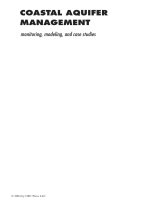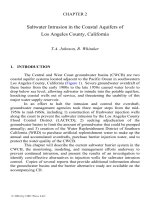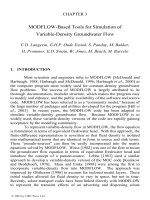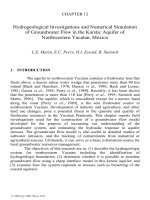Business ethics ethical decision making and case 10e chapter 12
Bạn đang xem bản rút gọn của tài liệu. Xem và tải ngay bản đầy đủ của tài liệu tại đây (6.21 MB, 30 trang )
Part Four
Implementing
Business Ethics
in a Global
Economy
Chapter 12
Sustainability:
Ethical and Social
Responsibility
Dimensions
© 2015 Cengage Learning. All rights reserved. May not be copied, scanned, or duplicated, in whole or in part,
1
Defining
Sustainability
Sustainability, from a strategic business
perspective
Is the potential for the long-term well-being
of the natural environment, including all
biological entities
As well as the mutually beneficial interactions
among nature and individuals, organizations,
and business strategies
Sustainability can have different definitions in
different cultures
© 2015 Cengage Learning. All rights reserved. May not be copied, scanned, or duplicated, in whole or in part,
2
Sustainable
Companies
Company
Industry
Country
Umicore
Materials
Belgium
Natura Cosmeticos
Consumer Staples
Brazil
Statoil
Energy
Norway
Neste Oil
Energy
Finland
Novo Nordisk
Health care
Denmark
Storebrand
Financials
Norway
Koninklijke Philips
Electronics
Industrials
Netherlands
Biogen Idec
Health care
United States
Dassault Systems
Information
Technology
France
Westpac Banking
Financials
Australia
Source: Jacquelyn Smith, “The World’s Most Sustainable Companies,” Forbes , January 23, 2013, />the-worlds-most-sustainable-companies/ (accessed March 15, 2013).
© 2015 Cengage Learning. All rights reserved. May not be copied, scanned, or duplicated, in whole or in part,
3
Sustainability, Ethics
and Social Responsibility
Corporate Social Responsibility (CSR) is a
corporate issue because:
CSR can create competitive advantages
Stakeholders have more power with increased
access to information, both positive and negative
Companies can use their brand identity to create
social value, quality and customer loyalty
Allows a firm to differentiate themselves and
promote their products
Social responsibility is part of the budget,
sustainability is a tool for ethical decision
making and financial performance
© 2015 Cengage Learning. All rights reserved. May not be copied, scanned, or duplicated, in whole or in part,
4
Ethical Decisions
Affect Sustainability
© 2015 Cengage Learning. All rights reserved. May not be copied, scanned, or duplicated, in whole or in part,
5
Global Environmental
Issues
Atmospheric
The most far reaching and controversial issues
relate to the air we breathe
Water
All businesses must think about water
conservation, purification and allocation
Land
Businesses have an ethical responsibility to
minimize their harmful impact on the land
© 2015 Cengage Learning. All rights reserved. May not be copied, scanned, or duplicated, in whole or in part,
6
Atmospheric
Issues
Air pollution – comes from three sources
Stationary (factories and power plants)
Mobile (autos, planes, trains)
Natural (windblown dust and volcanic eruptions)
Acid rain
When certain elements in air pollution mix with
air and water to create a new element, falling
from the sky as corrosive rain
Can corrode paint and deteriorate stone
© 2015 Cengage Learning. All rights reserved. May not be copied, scanned, or duplicated, in whole or in part,
7
Atmospheric
Issues
Most scientists believe our concentration of
greenhouse gases accelerates global
warming, a natural phenomenon
The Kyoto Protocol was an international
treaty to address greenhouse gas emissions
While it failed, it led to other initiatives, recently
the Doha Gateway Agreement
Some countries have implemented
cap-and-trade programs for coal
burning, the dirtiest form of energy
© 2015 Cengage Learning. All rights reserved. May not be copied, scanned, or duplicated, in whole or in part,
8
Water
Issues
Water pollution
Pollutants can come from various sources with
many unknown side effects on humans and
wildlife
Contaminated oceans compromise human food
supplies
Water quantity
While concerned about quality, some countries
are increasingly worried about water quantity
© 2015 Cengage Learning. All rights reserved. May not be copied, scanned, or duplicated, in whole or in part,
9
Facts About
Water Pollution
1. Up to 90 % of wastewater in developing countries flow untreated to rivers, lakes and coastal
zones.
2. Many industries such as leather and chemicals are moving from high-income countries to
emerging market economies where pollution laws are not enforced.
3. Every day, 2 million tons of untreated human waste is put into some water source.
4. In developing countries, 70 percent of industrial waste is dumped untreated into water sources.
5. Projected increases in fertilizer use for food production and in wastewater effluents over the
next three decades suggest there will be a 10 % to 20 % global increase in nitrogen water
contamination.
6. Common organic water pollutants include detergents, disinfection by-products, food processing
waste, insecticides and herbicides, petroleum hydrocarbons, Volatile organic compounds,
chlorinated solvents, polychlorinated biphenyl (PCBs), trichloroethylene, and perchlorate
7. Common inorganic water pollutants include acidity caused by industrial discharges, ammonia
from food processing waste, chemical waste as industrial byproducts, fertilizers containing
nutrients, heavy metals from motor vehicles, and acid mine drainage.
8. Macroscopic pollution (large visible items polluting the water) include urban storm water,
marine debris, trash or garbage, nurdles (small ubiquitous waterborne plastic pellets),
shipwrecks, and large derelict ships.
Sources: 2012 UN Water Statistics ; Allen Burton, Jr., and Robert Pitt, Stormwater Effects Handbook: A Toolbox for
Watershed Managers, Scientists, and Engineers , New York: CRC/Lewis Publishers, 2001; Thomas R. Schueler, "Cars Are Leading Source of Metal Loads
in California," Reprinted in The Practice of Watershed Protection , Ellicott City, MD: Center for Watershed Protection, 2000.
© 2015 Cengage Learning. All rights reserved. May not be copied, scanned, or duplicated, in whole or in part,
10
Land
Issues
Land pollution
Results from residential and industrial waste,
strip mining and poor forest conservation
Causes health issues, habitat destruction, erosion,
altered waterways and poisoned groundwater
Waste management
Plastics, obsolete computers and cell phones in
our landfills leach chemicals into the Earth
Many stakeholders believe manufacturers should
be responsible for their products’ proper disposal
© 2015 Cengage Learning. All rights reserved. May not be copied, scanned, or duplicated, in whole or in part,
11
Land
Issues
Deforestation
Reasons include the boom in biofuels, poverty,
farming and short-term profits from lumber sales
Companies must take a long-term view of
environmental management
Urban sprawl
Transformed the U.S. from low-density
communities to large-scale suburban developments
© 2015 Cengage Learning. All rights reserved. May not be copied, scanned, or duplicated, in whole or in part,
12
Land
Issues
Biodiversity
Because each species plays a unique role in its
ecosystem, the loss of any one may threaten the
entire ecosystem
Genetically modified organisms
Controversial issue of transplanting genes from
one organism to another, creating a new life form
The long-term impact is unknown
© 2015 Cengage Learning. All rights reserved. May not be copied, scanned, or duplicated, in whole or in part,
13
Environmental
Policy and Regulation
Environmental Protection Agency (EPA)
The most influential regulatory agency; deals
with environmental issues and enforces
environmental legislation in the U.S.
Can file civil suits against companies that violate
environmental laws
Established five strategic goals that reflect public
priorities
© 2015 Cengage Learning. All rights reserved. May not be copied, scanned, or duplicated, in whole or in part,
14
Goals of the
EPA
Goal
Long-term Outcome
1
Taking Action on Climate Change and Improving Air Quality
2
Protecting America’s Water
3
Cleaning Up Communities and Advancing Sustainable
Development
4
Ensuring the Safety of Chemicals and Preventing Pollution
5
Better waste management, restoration of contaminated waste
sites, and emergency
response
Source: Environmental Protection Agency, “EPA Strategic Plan,” February 15, 2013, />(accessed February 22, 2013).
© 2015 Cengage Learning. All rights reserved. May not be copied, scanned, or duplicated, in whole or in part,
15
Environmental
Legislation
Clean Air Act – 1970
Holds important implications for businesses and
their relationships with consumers
Endangered Species Act – 1973
Established a program to protect endangered and
threatened species and their habitats
Toxic Substances Control Act – 1976
Tracks over 75,000 industrial chemicals
manufactured or imported into the U.S.
© 2015 Cengage Learning. All rights reserved. May not be copied, scanned, or duplicated, in whole or in part,
16
Environmental
Legislation
Clean Water Act – 1977
Makes it illegal to discharge pollutants in
navigable waters without a permit
Pollution Prevention Act – 1990
Focuses on reducing pollution through changes in
production, operation and raw material usage
© 2015 Cengage Learning. All rights reserved. May not be copied, scanned, or duplicated, in whole or in part,
17
Environmental
Legislation
Food Quality Protection Act – 1996
Includes new safety standards for how the
EPA regulates pesticides
Energy Policy Act – 2005
Focuses on promoting alternative energy in the
hopes to lessen U.S. dependence on foreign oil
© 2015 Cengage Learning. All rights reserved. May not be copied, scanned, or duplicated, in whole or in part,
18
Alternative
Energy Sources
Wind power
Holds great promise for the U.S. due to the Great
Plains – one of the greatest sources of wind power
on the planet
Geothermal power
Provides a constant source of heat and is more
reliable than other alternative fuels, but expensive
© 2015 Cengage Learning. All rights reserved. May not be copied, scanned, or duplicated, in whole or in part,
19
Alternative
Energy Sources
Solar power
100% renewable energy but the technology
remains expensive and inefficient
Nuclear power
Pollution free and cost competitive but remains
controversial due to dangers of meltdown and
waste storage
© 2015 Cengage Learning. All rights reserved. May not be copied, scanned, or duplicated, in whole or in part,
20
Alternative
Energy Sources
Biofuels
Corn ethanol is unsustainable but new
technologies using algae and grass hold promise
Hydropower
Largest form of renewable energy but
controversial due to habitat destruction
© 2015 Cengage Learning. All rights reserved. May not be copied, scanned, or duplicated, in whole or in part,
21
Business Response
to Sustainability Issues
Better environmental performance can
increase revenue
Access to new markets, product differentiation and
sale of air pollution technologies
Better environmental performance can
decrease costs
Improve risk management and stakeholder
relationships, reduce materials and energy
used and reduce capital and labor costs
© 2015 Cengage Learning. All rights reserved. May not be copied, scanned, or duplicated, in whole or in part,
22
Environmental and
Economic Performance
Source: “Stefan Ambec and Paul Lanoie,
“Does It Pay to Be Green? A Systematic
Overview,” The Academy of Management
Perspectives , 22 (4), November 2008, p. 47
© 2015 Cengage Learning. All rights reserved. May not be copied, scanned, or duplicated, in whole or in part,
23
Green
Marketing
Green Marketing is a strategic process
involving stakeholder assessment to create
long-term relationships with customers, while
maintaining, supporting and enhancing the
natural environment
Firms that want to become sustainability leaders
should embed sustainability into their values,
norms and beliefs
© 2015 Cengage Learning. All rights reserved. May not be copied, scanned, or duplicated, in whole or in part,
24
Greenwashing
Greenwashing involves misleading
consumers into thinking a product/service is
more environmentally friendly than it is
Research indicates greenwashing destroys
consumer trust and creates confusion
© 2015 Cengage Learning. All rights reserved. May not be copied, scanned, or duplicated, in whole or in part,
25









